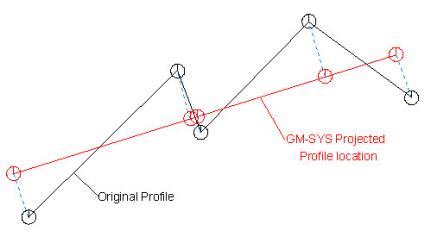New GM-SYS Model from Current Mark
The GMSMARK GX will create a GM-SYS Profile Modelling model from the currently marked data in a database. You may also include gradient data and import up to 15 horizons from elevation, depth, or two-way travel time channels for inclusion in the model. GM-SYS Profile Modelling is then launched to model the data.
The option is also available in Project Explorer from the context menu GM-SYS 2D Models > New GM-SYS 2D Model > From Current Mark.
New GM-SYS Model from Current Mark dialog options
|
Model name |
The name of the GM-SYS Profile Modelling model. |
|
Magnetic channel |
Magnetic anomaly channel. |
|
Magnetic elevation channel OR |
Magnetic observation elevations (+ up). |
|
Constant magnetic elevation |
Constant magnetic observation elevation; only used if no channel is specified as the magnetic elevations. |
|
Gravity channel |
Gravity channel (mGal, either Bouguer anomaly or free-air anomaly. |
|
Gravity elevation channel OR |
Gravity observation elevations (+ up). |
|
Constant gravity elevation |
Constant gravity field elevations, only used if no channel is specified as the gravity elevations. |
|
Topography channel OR |
Topography elevation channel (+ up). |
|
Constant topography elevation |
Constant topography elevation, only used if no channel is specified as the topography channel. |
|
Distance units |
Choose the distance units from the list. All distance units (including elevations) must be expressed in this unit. |
|
Maximum number of points in profile |
The maximum number of points to use in the model profile. If the data profile has fewer points, the data is used as selected. If the data profile has more points, the profile will be resampled to the maximum points specified here. The standard version of |
|
Profile Azimuth |
The direction of the profile (Y=0) from a real-world coordinate perspective. |
Horizons Options
|
Horizon values are… |
All horizon channels must contain either elevations (+UP), depths (+DOWN), or two-way travel time in seconds (+DOWN). Select the proper mode from the list. |
|
Horizon 1 channel |
Horizon channel. Values must be in Vertical Distance units for elevations or depths, as specified above, or in seconds for time channels. |
|
Horizon 2 channel |
Up to 15 horizon channels may be specified, from shallowest first to deepest. Surfaces may be coincident, but not cross. |
Gradients Options
|
Mag and Grav Gradient channel(s) |
Horizontal (Mx) & vertical magnetic gradient and six gravity gradient tensor components. Units for magnetic gradient are always nT/m; units for gravity gradients are always Eotvos. |
Batch Parameters
This GX will only work interactively.
Application Notes
The specified data in the mark will be written to an XYZ file named "<model>_gms.xyz", and the
The horizon channels may be either depth (+down), elevation (+up), or two-way travel time in seconds (+down). All horizons must use the same units and may not cross another horizon.
Note that XYZGMS converts a multi-segment line into a single-segment profile as shown below. The black line represents the original profile as digitised by the user. The red line is the location of the model profile in real-world X,Y space with values projected perpendicularly onto the model profile. The model-profile azimuth is based on the first and last points in the original profile. The profile location is then shifted to minimize the average mis-fit.
If you prefer to use distance along the line as the GM-SYS Profile Modelling X-coordinate, use the DISTCHAN GX (Utility | Make distance channel..) to generate a "X_dist" channel. Create a "Y_dist" channel containing all 0's. Then run the XYCOPY GX (Coordinates | Changes coordinates..) to set the default X,Y to X_dist,Y_dist. After running GMSMARK, you can easily resort the original X,Y by running the XYGET GX (Coordinates | Restore backup XY).
Got a question? Visit the Seequent forums or Seequent support
© 2023 Seequent, The Bentley Subsurface Company
Privacy | Terms of Use

